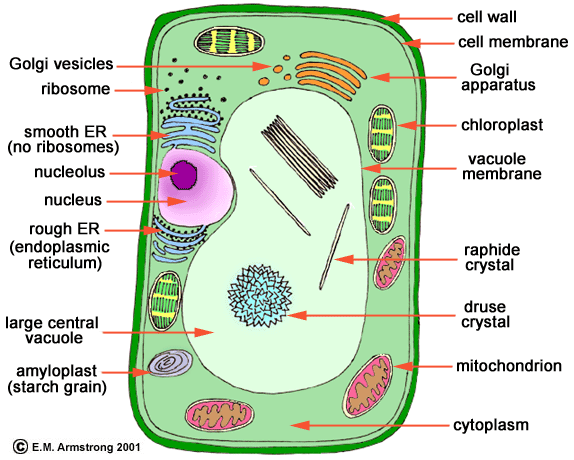Plants
They grow on mountains and in deserts. They grow in freshwater lakes and streams. They grow in the heat of the tropics and in places covered with snow. They even grow in the salt water of the ocean. What are they? Plants, of course!
WHAT IS A PLANT?
Plants are one of the five main groups of living things. These groups are called kingdoms. The plant kingdom includes such living things as grasses, trees, ferns, bushes, and flowers. Botanists, the scientists who study plants, have counted more than 260,000 species (kinds) of plants.
Plants vary greatly in size and shape. Some plants are so small they can hardly be seen. Other plants tower above the land. The giant sequoia trees of California are one of the largest living things on Earth. They can grow to heights of nearly 300 feet (90 meters)!
Just like animals, plants are made up of tiny structures called cells. But unlike animal cells, plant cells are surrounded by a stiff material called cellulose. Most animals move around and eat other things. Plants are different. Plants that grow on land usually stay in one place and make their own food.
Most plants are green because they have a green chemical called chlorophyll. Plants are different from mushrooms and other fungi. Fungi do not have chlorophyll.
WHAT ARE THE MAIN KINDS OF PLANTS?
Almost all the members of the plant kingdom are seed plants. They grow from seeds. Most seed plants are flowering plants, or angiosperms.
But there are some groups of plants that do not grow from seeds. Botanists call these groups bryophytes, ferns, lycophytes, and horsetails.
WHAT ARE FLOWERING PLANTS?
People who plant flower gardens fill them with flowering plants. Oaks, maples, and other trees that turn bright colors in autumn are flowering plants. The grasses on lawns are flowering plants. Almost all the fruits and vegetables you eat come from flowering plants.
Flowering plants make seeds that are inside a covering. Angiosperm, the name for flowering plants, means “enclosed seed.”
You probably have seen many seeds of angiosperms. The seeds are inside fruit. Bite into an apple, a peach, or a pear and you will find one or more seeds. The seeds started to grow inside the beautiful blossoms that covered these fruit trees in the spring.
WHAT ARE OTHER SEED PLANTS?
Unlike flowering plants, some seed plants make seeds that are not inside a covering. They are called gymnosperms, a word that means “naked seed.”
The best-known kinds of gymnosperms are conifers. Conifers are evergreens. They stay green all year long. Arborvitae, cedar, cypress, fir, hemlock, juniper, pine, and spruce trees are all conifers.
Conifers and other gymnosperms do not have flowers. Conifers do have leaves, but they are usually thin like needles. The seeds of conifers are in cones.
WHAT ARE THE MAIN PARTS OF PLANTS?
Most plants have three main parts: roots, stems, and leaves. The roots are in the ground. They hold the plant in the soil. Roots take up water and minerals the plant needs.
Stems usually are above ground. They carry food and water. The stems of some plants, such as dandelions, are thin and delicate. Trees have thick, strong stems. The stems are trunks covered with bark.
Leaves come out of the stems of plants. Green plants use light, water, minerals, and carbon dioxide (a gas in the air) to make food in their leaves.
Leaves have many different shapes. Some are sharp spines that protect the plant from animals. Some leaves are brightly colored. Flowers are a kind of leaf.
HOW DO PLANTS GROW?
Most plants grow from seeds. Seeds need soil, water, and light to grow. A bean is a seed. You can make a bean plant grow. Here’s how.
Put a bean in a paper cup filled with soil. Set the cup near a window where there is plenty of sunlight. Water the bean often. A root will grow downward from the bean. A green shoot will start to grow upward from the bean. Soon you will see leaves start to grow out of the shoot, or stem.
Wind and water may carry some seeds far from the plants that made them. Sometimes seeds are “planted” by animals that eat fruit. Apples, peaches, and cherries are examples of seed-bearing fruits that animals like to eat.
Cherries, for instance, are a favorite food of birds. After a bird has eaten the fruit, it may fly off and drop the cherry stone, or seed, far away. This seed may start to grow and make a new cherry tree.
WHERE DO SEEDS COME FROM?
Many kinds of plants have male and female parts. These plants reproduce, or make seeds, sexually. In flowering plants, the male and female parts are in the flowers. In pine trees and other conifers, the male and female parts are in the cones. Conifers have male and female cones.
The male part of a flower is called the stamen. It gives off a powdery substance called pollen. The female part is called the pistil. An egg forms in the pistil. Pollination occurs when some of the pollen gets to the pistil. A pollen grain joins with an egg. When this happens, a seed begins to grow.
In some species, the pollen and egg can come from the same plant. In other species, they must come from different plants. But how does pollen move? Insects, wind, and water can all help move the pollen.
Have you seen bees or butterflies around flowers? Bees and butterflies like to drink nectar from the flowers. As they enjoy their tasty treat, some of the pollen sticks to their bodies. They carry it with them to other flowers, leading to pollination.









No comments:
Post a Comment